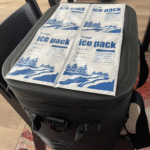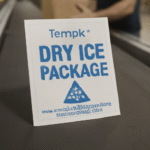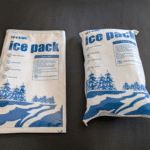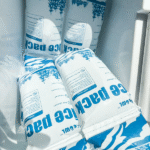En ce qui concerne l'expédition de produits sensibles à la température, choosing between glace carbonique et packs de glace can be crucial. Both options help preserve perishable items, but understanding their differences is key. Dans ce guide, we’ll dive into the benefits of each, helping you make the right choice for your specific needs.

Key Points to Consider:
-
What are the differences between dry ice and ice packs?
-
Which shipping conditions are ideal for each option?
-
How to maximize efficiency and safety when using dry ice or ice packs?
-
Which is more cost-effective and sustainable?
What Are the Key Differences Between Dry Ice and Ice Packs?
Glace sèche et packs de glace each have unique advantages, but choosing the right one depends on your needs.
Glace sèche
Dry ice is frozen dioxyde de carbone that sublimates at -109°F. Contrairement à la glace ordinaire, La glace sèche ne fonde pas dans le liquide, which means it keeps everything dry. It is ideal for long shipments, keeping items frozen for extended periods.
Packs de glace
Packs de glace, also called packs de gel, are filled with refrigerants or water and often used for shorter shipments. They are typically kept frozen and thaw over time, which means they are best for keeping items chilled, pas gelé.
Différences clés
| Fonctionnalité | Glace sèche | Packs de glace | Votre avantage |
|---|---|---|---|
| Température | -109°F | 35°F to 45°F | Dry ice keeps items frozen, ice packs maintain a chilled state |
| Longévité | Lasts 5-7 jours | Lasts up to 6 heures | Dry ice is better for long-distance shipments |
| Sécurité | Risk of burns, requires special handling | Easier to handle, plus sûr | Ice packs are easier and safer for regular handling |
| Coût | More expensive | Plus abordable | Ice packs are less costly for short shipments |
Which One Should You Use for Shipping Perishable Goods?
Packs de glace: Best for Short-Term, Local Shipments
Packs de glace are the best choice for shipping chilled items that don’t need to remain frozen for long. They are ideal for local deliveries ou one-day shipments of products like dairy, légumes, and fresh meat.
Glace sèche: Best for Long-Distance, Frozen Shipments
For items that need to remain frozen over multiple days—like viandes surgelées, fruit de mer, ou glace-glace carbonique is the optimal solution. It lasts much longer than ice packs and doesn’t create liquid messes, keeping the contents dry and frozen.
How to Maximize Efficiency and Safety with Dry Ice and Ice Packs?
Pre-chill Your Items
For both glace carbonique et packs de glace, pre-chilling your products before packaging ensures maximum cold retention. Refrigerate items for at least 12 hours prior to packing.
Layer Your Pack Effectively
When using glace carbonique, ensure that 60% of your dry ice is placed at the bottom, et 40% is placed on top to ensure even cooling. Pour packs de glace, use a similar approach, but ensure they are packed tightly around your items to reduce air exposure and maximize cooling efficiency.
Monitor Temperature Throughout Shipping
It’s vital to include temperature monitors when shipping with either dry ice or ice packs, en particulier pour critical shipments like pharmaceuticals or biologics. En utilisant disposable temperature loggers can ensure that items remain within the required temperature range.
What Are the Pros and Cons of Each?
Ice Packs – Pros and Cons
Pros:
-
Rentable: Ice packs are affordable and available in bulk.
-
Safe to Handle: No risk of burns, making them easy to use for most handlers.
-
Réutilisable: Many ice packs can be frozen and reused multiple times.
-
Best for short distances: Perfect for 1-day ground shipments.
Inconvénients:
-
Limited Cold Retention: Only effective for about 6 heures.
-
Not ideal for freezing: Items may only stay chilled, pas gelé.
-
Impact environnemental: Many ice packs are made with plastic and may not be eco-friendly.
Dry Ice – Pros and Cons
Pros:
-
Keeps items frozen: Ideal for items requiring températures ultra-faibles.
-
Longue durée: Can last for 5-7 days depending on conditions.
-
Environmentally friendly: Sublimates without creating liquid waste.
-
Ideal for long-distance: Perfect for national or international shipments.
Inconvénients:
-
Dangerous: Requires special handling due to risk of burns and asphyxiation.
-
Costly: More expensive than ice packs.
-
Limited availability: May not be as easy to obtain as gel packs.
-
Regulatory restrictions: Some shipping companies have strict rules for transporting dry ice.
2025 Shipping Trends and Innovations
Shipping trends are moving towards more durable et efficace cooling methods. Here’s what’s new in 2025:
-
Eco-friendly solutions: More companies are using biodegradable gel packs ou plant-based dry ice containers.
-
Tracking technology: RFID tags and IoT temperature monitors are becoming standard for tracking shipment conditions in real time.
-
Cost-saving measures: Due to rising dry ice prices, companies are shifting towards more cost-effective options like reusable ice packs for shorter shipments.
Latest Advances
-
RFID technology: Provides live tracking for dry ice or gel packs, allowing real-time adjustments during transit.
-
Matériaux à changement de phase: Developments in smart cold storage are enhancing the efficiency of dry ice and gel packs.
Questions fréquemment posées (FAQ)
1. Combien de temps durent des packs de glace sec en transit?
Dry ice can last 5-7 days when used correctly in well-insulated packaging, depending on the quantity and shipment conditions.
2. Are ice packs reusable?
Oui, many ice packs are designed to be reusable. Simply refreeze them and they’re ready for the next shipment.
3. Can I use dry ice for food shipments?
Absolument! Dry ice is ideal for shipping frozen foods, y compris la viande, fruit de mer, et glace, but it requires careful handling and adherence to shipping regulations.
Conclusion et recommandations
Glace sèche is the best choice for long-distance, frozen shipments, ensuring your items stay completely frozen. Packs de glace, d'autre part, are more cost-effective and best for short-term, local deliveries that don’t require freezing.
Étapes suivantes
-
Consider the distance and time: For long-distance shipments, opt for dry ice.
-
Prioritize safety: If using dry ice, ensure proper handling and check regulations.
-
Use reusable packs: For frequent shipments, invest in reusable ice packs to cut down on costs.
À propos du tempk
À Rotation, we provide cutting-edge Solutions de chaîne froide tailored to meet your shipping needs. Notre dry ice products are tested to maintain -78°C pour jusqu'à 120 heures, ensuring the safety and integrity of your perishable goods.
Contactez-nous aujourd'hui to optimize your shipping with our advanced cold chain technology!























